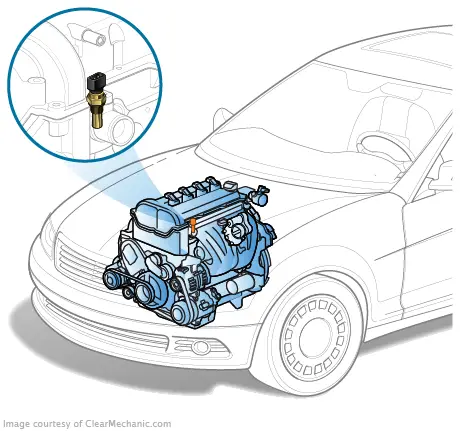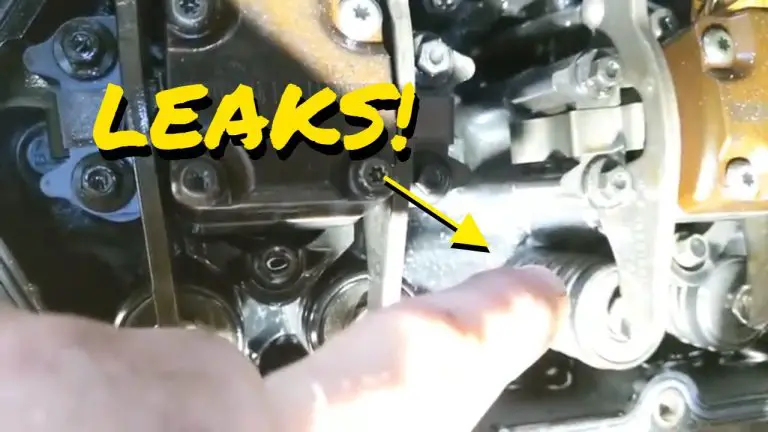Cost to Replace Coolant Temperature Sensor : Affordable Solution
Replacing a coolant temperature sensor is an essential maintenance task for any vehicle. The coolant temperature sensor, also known as the engine coolant temperature (ECT) sensor, plays a crucial role in the proper functioning of the engine. It measures the temperature of the engine coolant and sends this information to the engine control unit (ECU) to adjust the air-fuel mixture and ignition timing. A faulty coolant temperature sensor can lead to various issues such as poor fuel economy, rough idling, and engine overheating.
A healthy engine cooling system is vital for your car’s performance and longevity. The coolant temperature sensor plays a critical role in this system, constantly monitoring engine temperature and relaying this information to the engine computer (ECU). This data is crucial for regulating engine functions like fan operation and fuel mixture, ensuring optimal performance and preventing overheating. But what happens when this sensor malfunctions?
How much does it cost to replace a coolant temperature sensor?
The cost to replace a coolant temperature sensor can vary depending on the make and model of the vehicle, as well as the labor rates in your area. On average, the cost of the sensor itself ranges from $20 to $100, while the labor cost can be anywhere from $50 to $150. Therefore, the total cost to replace a coolant temperature sensor typically falls between $70 and $250.

Credit: www.youtube.com
Signs of a Failing Coolant Temperature Sensor (Uh Oh!)
A malfunctioning coolant temperature sensor can wreak havoc on your engine’s delicate temperature balance. Here are some warning signs to watch out for:
- Overheating Engine: This is a major red flag! If your car’s temperature gauge climbs into the red zone, a faulty coolant temperature sensor might be sending incorrect readings to the ECU, causing the engine to run hotter than necessary.
- Inconsistent Temperature Gauge: Fluctuating temperature gauge readings can also indicate a problem with the sensor. The gauge might jump erratically or display abnormally high or low readings.
- Check Engine Light: While not exclusive to a bad coolant temperature sensor, the illumination of the check engine light often signifies an engine management issue. Retrieving the trouble codes with a scan tool can provide more specific details.
- Poor Engine Performance: An incorrect engine temperature reading can disrupt optimal air-fuel mixture and engine timing, leading to symptoms like rough idling, hesitation, and reduced power.
- Black Smoke from Exhaust: In some cases, a faulty sensor can cause the engine to run rich (too much fuel), resulting in black smoke emitting from the exhaust pipe.
If you’re experiencing any of these signs, it’s crucial to address the issue promptly to prevent potential engine damage caused by overheating. The next section will explore the costs associated with replacing a coolant temperature sensor.
Cost to Replace a Coolant Temperature Sensor: Understanding the Breakdown
A failing coolant temperature sensor can disrupt your car’s engine performance and lead to overheating issues. The good news? Replacing the sensor itself is often a relatively inexpensive repair. But how much will it really cost? This section will break down the factors affecting the total cost.
Understanding the Bill:
The overall cost of replacing a coolant temperature sensor can be divided into two main parts:
- Parts Cost: The sensor itself is typically an affordable component. Coolant temperature sensors can range anywhere from $20 to $50, depending on your car’s make, model, and the sensor’s quality (OEM vs. aftermarket).
- Labor Cost: The labor involved in replacing the sensor can vary depending on the complexity of the job and the mechanic’s hourly rate. In general, expect labor costs to fall between $60 and $100.
DIY vs. Mechanic:
If you’re mechanically inclined and comfortable working on your car, replacing the coolant temperature sensor yourself can be a budget-friendly option. However, there are factors to consider:
- Complexity: While sensor replacement isn’t the most intricate repair, accessing the sensor’s location on some vehicles can be tricky. Research your specific car model to understand the replacement process involved.
- Tools Required: You might need basic tools like wrenches, screwdrivers, and possibly a coolant system refill kit.
Additional Factors Affecting Cost:
- Shop Location: Labor rates can vary depending on your geographic location. Mechanics in urban areas typically charge more per hour than those in rural areas.
- Shop Reputation: Reputable repair shops might charge slightly more than budget chains, but they often provide warranty on their work and use high-quality parts.
Total Cost Estimate:
Taking everything into account, replacing a coolant temperature sensor can range anywhere from $80 to $150, with the cost split between parts and labor. Opting for a DIY repair can potentially bring the cost down to the price of the part itself, but mechanic rates can vary.
Remember: If you’re unsure about tackling the replacement yourself, consulting a qualified mechanic is always the safe and reliable option.
Factors Affecting the Replacement Cost
Several factors can influence the overall cost of replacing a coolant temperature sensor:
- Make and model of the vehicle
- Location of the sensor
- Labor rates in your area
- Quality of the replacement sensor
DIY vs. Professional Replacement
While replacing a coolant temperature sensor is a fairly manageable task for a DIY mechanic, it is important to consider the potential risks and complications. If you have experience with automotive repairs and access to the necessary tools, you may be able to save on labor costs by replacing the sensor yourself. However, if you are unsure about the process or lack the required expertise, it is advisable to seek professional help to ensure the job is done correctly.
A failing coolant temperature sensor can disrupt your engine’s performance, but the good news is that replacing it can be a relatively affordable repair. However, the question remains: should you tackle the job yourself or entrust it to a mechanic? This section will help you weigh the options.
The Case for DIY:
- Cost Savings: The biggest advantage of DIY repair is the potential to save money on labor costs.
- Sense of Accomplishment: Successfully completing the repair yourself can be a rewarding experience.
- Control Over the Process: You’ll have complete control over the quality of parts used and the repair process itself.
DIY Considerations:
- Mechanical Knowledge: Replacing a coolant temperature sensor requires a basic understanding of how the cooling system works and some mechanical aptitude.
- Tools Required: You’ll need a basic set of tools like wrenches, screwdrivers, and possibly a coolant system refill kit. Research your specific car model to determine the exact tools required.
- Time Commitment: While not an extensive repair, factor in the time it takes to research the process, gather tools, and complete the replacement.
- Access and Complexity: On some vehicles, accessing the coolant temperature sensor can be tricky. Ensure you have a clear understanding of the sensor’s location and the steps involved in the replacement process for your car model. There are many online DIY guides and video tutorials available, but they might not be specific to your vehicle.
The Case for Mechanic:
- Expertise and Efficiency: Qualified mechanics have the experience and knowledge to diagnose and replace the sensor efficiently.
- Guaranteed Work: Most repair shops offer warranties on their labor, providing peace of mind in case of any issues after the replacement.
- Access to Tools and Resources: Mechanics have access to specialized tools and resources that might not be readily available to DIYers.
Mechanic Considerations:
- Cost: Mechanic labor rates will add to the overall cost of the repair.
- Scheduling: Finding a shop with available appointments might require some flexibility.
Who Should Replace Your Coolant Temperature Sensor?
The decision ultimately boils down to your comfort level, mechanical expertise, and budget. Here’s a quick guide:
- Choose a Mechanic If: You’re unsure about your mechanical skills, lack the necessary tools, or prioritize the ease and warranty of professional repair.
- Consider DIY If: You’re a mechanically inclined person with the necessary tools and are comfortable working on your car. Remember, prioritize safety and consult a professional if you have any doubts about your ability to complete the replacement correctly.
Safety First!
Always prioritize safety when working on your car’s cooling system. Coolant can be hot and harmful if not handled properly. Ensure you wear appropriate safety gear, consult a repair manual for your specific vehicle, and dispose of used coolant responsibly.
Credit: www.quora.com
Consequences of Driving with a Faulty Coolant Temperature Sensor
Driving with a faulty coolant temperature sensor can have detrimental effects on your vehicle’s performance and longevity. Some potential consequences include:
- Poor fuel economy
- Engine overheating
- Difficulty starting the engine
- Rough idling and stalling
Therefore, it is important to address any issues with the coolant temperature sensor promptly to prevent further damage to the engine and related components.
Additional Tips for Saving on Coolant Temperature Sensor Replacement
Replacing a faulty coolant temperature sensor is a cost-effective way to keep your engine running cool and avoid potential overheating damage. Here are some additional tips to stretch your repair budget even further:
- Diagnose the Problem Yourself (If Comfortable): While not a substitute for professional diagnosis, some basic checks can help you determine if a faulty coolant temperature sensor is the culprit. Symptoms like overheating gauge readings, erratic engine performance, and the check engine light can all point towards a sensor issue. However, if you’re unsure about the cause of the problem, it’s always best to consult a qualified mechanic for an accurate diagnosis.
- Compare Mechanic Quotes: If you’re opting for professional repair, get quotes from several repair shops in your area. Labor rates can vary, so shopping around can help you find the most competitive price.
- Consider Using Aftermarket Parts (With Caution): OEM (original equipment manufacturer) parts are guaranteed to be compatible with your car, but they often come at a premium price. Aftermarket parts can be a more affordable option, but it’s crucial to choose a reputable brand known for quality.
- DIY with Caution: If you’re a mechanically savvy person and the sensor replacement process on your car seems manageable, tackling the repair yourself can be a significant cost saver. However, prioritize safety and only proceed if you’re comfortable working on your car’s cooling system. There are many online DIY guides and video tutorials available, but ensure they specifically match your vehicle’s make and model.
- Look for Online Coupons and Deals: Many repair shops offer online coupons or discounts for first-time customers. Searching online can help you find deals on both parts and labor costs.
- Perform Preventative Maintenance: Regularly maintaining your car’s cooling system can help prevent problems with the coolant temperature sensor in the first place. This includes checking coolant levels and condition, replacing the coolant at recommended intervals, and ensuring the radiator and cooling fans are functioning properly.
By following these tips, you can keep the cost of replacing a coolant temperature sensor under control and ensure your car’s engine cooling system is running smoothly. Remember, a healthy cooling system is vital for optimal engine performance and longevity.
Frequently Asked Questions
Is It Expensive To Fix A Coolant Temperature Sensor?
The cost to fix a coolant temperature sensor varies depending on the make and model of the vehicle, as well as the location of the repair shop. On average, the cost ranges from $150 to $200 for parts and labor.
However, it is always recommended to get a quote from a certified mechanic.
How Long Does It Take To Replace A Coolant Temperature Sensor?
Replacing a coolant temperature sensor typically takes about 1-2 hours. It’s a relatively straightforward task.
Is Coolant Temperature Sensor Easy To Replace?
Replacing a coolant temperature sensor is a manageable task for DIY mechanics. Take note of the sensor’s location before starting.
Can You Drive With A Broken Coolant Temp Sensor?
Driving with a broken coolant temp sensor is not recommended due to potential negative consequences for your vehicle. While it may be possible for short distances, it’s best to avoid long drives or extended periods with a faulty sensor.
Conclusion
Replacing a coolant temperature sensor is a crucial maintenance task that should not be overlooked. While the cost of replacement may vary, addressing any issues with the sensor in a timely manner can help ensure the proper functioning of your vehicle’s engine and avoid more significant and costly repairs in the future.




